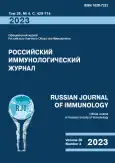Отличия в спектре микробиоты кожи и параметрах локального иммунитета в очаге воспаления у дерматологических больных от здоровых людей
- Авторы: Сенникова С.В.1, Топтыгина А.П.1,2, Воропаева Е.А.1,3
-
Учреждения:
- ФБУН «Московский научно-исследовательский институт эпидемиологии и микробиологии имени Г.Н. Габричевского» Роспотребнадзора
- ФГБОУ ВО «Московский государственный университет имени М.В. Ломоносова»
- ФГАОУ ВО «Российский национальный исследовательский медицинский университет имени Н.И. Пирогова» Министерства здравоохранения РФ
- Выпуск: Том 26, № 4 (2023)
- Страницы: 477-484
- Раздел: Школа Клинической Иммунологии "Сочи-2023"
- URL: https://journals.rcsi.science/1028-7221/article/view/253430
- DOI: https://doi.org/10.46235/1028-7221-13086-DIT
- ID: 253430
Цитировать
Полный текст
Аннотация
Нарушение состава нормальной микробиоты является триггерным, а иногда и этиологическим фактором развития хронических заболеваний кожи, таких как псориаз или экзема. Распознавание микрофлоры кератиноцитами и иммунокомпетентными клетками приводит к продукции антимикробных пептидов, хемокинов и ростовых факторов, что способствует дифференцировке Т-лимфоцитов в аутоагрессивные эффекторы Th1-, Th17- и Th22-типов, реализующие аутоиммунное воспаление в псориатической бляшке. Целью работы было исследование различий в спектре микробиоты кожи и параметров локального иммунитета в капиллярной крови, взятой рядом с очагом воспаления у больных с аутоиммунным (псориаз) и аллергическим (экзема) заболеванием по сравнению с параметрами здоровых людей. Обследованы 24 больных псориазом (группа 1), 20 больных экземой (группа 2) и 20 здоровых взрослых (группа 3). Взятие биологического материала (мазок стерильным сухим тампоном в транспортную систему Amies с активированным углем и взятие капиллярной крови в 2 микроветы по 200 мкл) проводили из очагов воспаления на коже кистей рук у пациентов или из пальца кистей рук у здоровых. Выполняли посевы на диагностические среды, микроскопию с окраской по Граму и идентификацию на микробиологическом анализаторе. Иммунофенотипирование 22 субпопуляций мононуклеаров проводили путем четырехцветного окрашивания цельной капиллярной крови с лизированием эритроцитов и оценкой субпопуляций на проточном цитометре. Цитокины в плазме крови определяли мультиплексным методом. Спектр микрофлоры кожи рук группы 3 был более разнообразным по видовому составу. У пациентов с псориазом и экземой доминировала кокковая флора, со сдвигом спектра микробиоты в сторону условно патогенных микроорганизмов. Обнаружена активация Т- и В-клеток, продукция провоспалительных цитокинов, цитокинов оси IL-23/IL-17/IL-22 и цитокинов – маркеров повреждения клеток эпителия (IL-25 и IL-33), а также недостаточность противовоспалительных факторов. Выявлены различия в изменениях параметров локального иммунного статуса у больных с аутоиммунным (псориаз) и аллергическим (экзема) заболеваниями, отражающие особенности иммунопатогенеза этих заболеваний.
Ключевые слова
Полный текст
Открыть статью на сайте журналаОб авторах
С. В. Сенникова
ФБУН «Московский научно-исследовательский институт эпидемиологии и микробиологии имени Г.Н. Габричевского» Роспотребнадзора
Email: drsennikova@mail.ru
аспирант лаборатории цитокинов ФБУН «Московский научно-исследовательский институт эпидемиологии и микробиологии имени Г.Н. Габричевского» Роспотребнадзора
Россия, МоскваАнна Павловна Топтыгина
ФБУН «Московский научно-исследовательский институт эпидемиологии и микробиологии имени Г.Н. Габричевского» Роспотребнадзора; ФГБОУ ВО «Московский государственный университет имени М.В. Ломоносова»
Автор, ответственный за переписку.
Email: toptyginaanna@rambler.ru
д.м.н., профессор, главный научный сотрудник, руководитель лаборатории цитокинов ФБУН «Московский научно-исследовательский институт эпидемиологии и микробиологии имени Г.Н. Габричевского» Роспотребнадзора; профессор кафедры иммунологии ФГБОУ ВО «Московский государственный университет имени М.В. Ломоносова»
Россия, Москва; МоскваЕ. А. Воропаева
ФБУН «Московский научно-исследовательский институт эпидемиологии и микробиологии имени Г.Н. Габричевского» Роспотребнадзора; ФГАОУ ВО «Российский национальный исследовательский медицинский университет имени Н.И. Пирогова» Министерства здравоохранения РФ
Email: voropaeva@gabrich.ru
д.б.н., главный научный сотрудник, руководитель отдела медицинской биотехнологии ФБУН «Московский научно-исследовательский институт эпидемиологии и микробиологии имени Г.Н. Габричевского» Роспотребнадзора; профессор кафедры микробиологии и вирусологии ФГАОУ ВО «Российский национальный исследовательский медицинский университет имени Н.И. Пирогова» Министерства здравоохранения РФ
Россия, Москва; МоскваСписок литературы
- Теличко И.Н., Белоусова И.Э., Хайрутдинов В.Р. Дерматовенерология. Учебник. 3-е изд., перераб. и доп. М.: ГЭОТАР-Медиа, 2016. 432 с. [Telichko I.N., Belousova I.E., Khairutdinov V.R. Dermatovenereology. Textbook. 3rd ed., rev. and suppl.]. Moscow: GEOTAR-Media, 2016. 432 p.
- Bodoor K., Al-Qarqaz F., Heis L.A., Alfaqih M.A., Oweis A.O., Almomani R., Obeidat M.A. IL-33/13 Axis and IL-4/31 axis play distinct roles in inflammatory process and itch in psoriasis and atopic dermatitis. Clin. Cosmet. Investig. Dermatol. 2020, Vol. 13, pp. 419-424.
- Buchau A.S., Gallo R.L. Innate immunity and antimicrobial defense systems in psoriasis. Clin. Dermatol. 2007, Vol. 25, no. 6, pp. 616-624.
- Chang H.W., Yan D., Singh R., Liu J., Lu X., Ucmak D., Lee K., Afifi L., Fadrosh D., Leech J., Vasquez K.S., Lowe M.M., Rosenblum M.D., Scharschmidt T., Lynch S.V., Liao W. Alteration of the cutaneous microbiome in psoriasis and potential role in Th17 polarization. Microbiome, 2018, Vol. 6, 154. doi: 10.1186/s40168-018-0533-1.
- Dainichi T., Kitoh A., Otsuka A., Nakajima S., Nomura T., Kaplan D.H., Kabashima K. The epithelial immune microenvironment (EIME) in atopic dermatitis and psoriasis. Nat. Immunol., 2018, Vol. 19, no. 12, pp. 1286-1298.
- Goodman W.A., Cooper K.D., McCormick T.S. Regulation generation: the suppressive functions of human regulatory T cells. Crit. Rev. Immunol., 2012, Vol. 32, no. 1, pp. 65-79.
- Grice E.A., Kong H.H., Conlan S., Deming C.B., Davis J., Young A.C., Bouffard G.G., Blakesley R.W., Murray P.R., Green E.D., Turner M.L., Segre J.A. Topographical and temporal diversity of the human skin microbiome. Science, 2009, Vol. 324, no. 5931, pp. 1190-1192.
- Langan E.A., Griffiths C.E.M., Solbach W., Knobloch J.K., Zillikens D., Thaci D. The role of the microbiome in psoriasis: moving from disease description to treatment selection? Br. J. Dermatol., 2018, Vol. 178, no. 5, pp. 1020-1027.
- Nakamura Y., Oscherwitz J., Cease K.B., Chan S.M., Muñoz-Planillo R., Hasegawa M., Villaruz A.E., Cheung G.Y., McGavin M.J., Travers J.B., Otto M., Inohara N., Núñez G. Staphylococcus delta-toxin induces allergic skin disease by activating mast cells. Nature, 2013, Vol. 503, no. 7476, pp. 397-401.
- Rendon A., Schäkel K. Psoriasis pathogenesis and treatment. Int. J. Mol. Sci., 2019, Vol. 20, 1475. doi: 10.3390/ijms20061475.
- Yerushalmi M., Elalouf O., Anderson M., Chandran V. The skin microbiome in psoriatic disease: a systematic review and critical appraisal. J. Trans. Autoimmun., 2019, Vol. 2, 100009. doi: 10.1016/j.jtauto.2019.100009.
- Zheng Y., Hunt R.L., Villaruz A.E., Fisher E.L., Liu R., Liu Q., Cheung G.Y.C., Li M., Otto M. Commensal Staphylococcus epidermidis contributes to skin barrier homeostasis by generating protective сeramides. Cell Host Microbe, 2022, Vol. 30, pp. 301-313.
Дополнительные файлы







